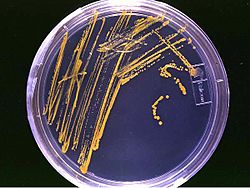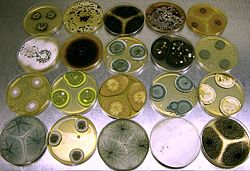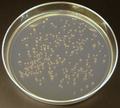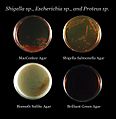Agar plate facts for kids

An agar plate is a Petri dish that contains agar and some nutrients (food for the microorganisms). It is used to grow microorganisms. For example, a blood sample of a patient may be put on agar plate, to let the bacteria that made the patient sick grow. These bacteria can then be identified using a microscope to let the doctor choose the appropriate treatment of the patient.
When microorganisms grow on the agar plate, they form colonies. Each colony has similar genetic characteristics.
There are many types of agar plates that are used, but the two main types are defined and undefined. An undefined plate's nutrients aren't exactly known, but everything in a defined plate is accounted for.
Related pages
Images for kids
-
An agar culture of E. coli colonies
-
Red blood cells on an agar plate are used to diagnose infection. On the left is a positive Staphylococcus infection, on the right a positive Streptococcus culture.
-
Hemolyses of Streptococcus spp. (left) α-hemolysis (S. mitis); (middle) β-hemolysis (S. pyogenes); (right) γ-hemolysis (= nonhemolytic, S. salivarius)
-
Four types of agar plate demonstrating differential growth depending on bacterial metabolism
See also
 In Spanish: Placa de agar para niños
In Spanish: Placa de agar para niños










